International Student Guide - Ion Ionescu de la Brad
International Student Guide - Ion Ionescu de la Brad
International Student Guide - Ion Ionescu de la Brad
You also want an ePaper? Increase the reach of your titles
YUMPU automatically turns print PDFs into web optimized ePapers that Google loves.
THE “ION IONESCU DE LA BRAD” UNIVERSITY OF AGRICULTURAL<br />
SCIENCES AND VETERINARY MEDICINE<br />
IASI - ROMANIA<br />
LIFELONG LEARNING PROGRAMME - ERASMUS PROGRAMME<br />
INTERNATIONAL STUDENT GUIDE<br />
ACADEMIC YEAR 2011 – 2012<br />
INTERNATIONAL RELATIONS DEPARTMENT<br />
ERASMUS OFFICE
Editorial staff:<br />
Nico<strong>la</strong>e MUNTEANU<br />
Veronica APETREI<br />
Simona AVARVAREI<br />
Booklet printed with funds from the ERASMUS Programme
Welcome<br />
Dear stu<strong>de</strong>nt,<br />
It is a great pleasure for me to<br />
welcome you to the “<strong>Ion</strong> <strong>Ion</strong>escu<br />
<strong>de</strong> <strong>la</strong> <strong>Brad</strong>” University of Agricultural Sciences<br />
and Veterinary Medicine, Iaşi.<br />
We like to think that everyone who wants to<br />
learn and grow can find the opportunity at our<br />
University, and if you consi<strong>de</strong>r joining us, you<br />
will discover a world and civilization you may<br />
know little about, but soon you will realise that<br />
you are at the very heart of the European<br />
environment, circumscribed to a cultural<br />
dimension where differences are merely<br />
noticeable.<br />
Iasi has a generous cultural vocation, in<br />
general, and an important aca<strong>de</strong>mic one, in<br />
particu<strong>la</strong>r. The outstanding scenery that<br />
surrounds the town harmoniously interweaves<br />
itself with the intellectual ebullience of the<br />
young, bringing thus a touch of uniqueness and<br />
freshness.<br />
3<br />
Our University is pleased to have you as guest<br />
and stu<strong>de</strong>nt, and we have the certainty that you<br />
will have the opportunity to wi<strong>de</strong>n both your<br />
professional and spiritual horizon. You will meet<br />
new people, make new friends, and together<br />
you may start thinking of a common European<br />
future, which is currently shaping out.<br />
Thank you for consi<strong>de</strong>ring the “<strong>Ion</strong> <strong>Ion</strong>escu <strong>de</strong><br />
<strong>la</strong> <strong>Brad</strong>” University; our prospectus is <strong>de</strong>signed<br />
as an ‘easy-to-use’ gui<strong>de</strong> to help you find the<br />
right programme. As a leading research<br />
institution, we p<strong>la</strong>ce great value on graduate<br />
stu<strong>de</strong>nts, and we will also provi<strong>de</strong> you with the<br />
opportunity to work closely and be taught by an<br />
outstanding aca<strong>de</strong>mic staff, always happy to<br />
help you.<br />
Professor Vasile VÎNTU, PhD<br />
Rector
OUR COUNTRY<br />
- ROMANIA -<br />
Romania joined NATO on March 29, 2004, the<br />
European Union on January 1, 2007 and is also a<br />
member of the Latin Union, of the Francophonie, of<br />
the OSCE, of the WTO, of the BSEC and of the<br />
United Nations. Today, Romania is a unitary semipresi<strong>de</strong>ntial<br />
republic, in which the executive branch<br />
consists of the Presi<strong>de</strong>nt and the Government.<br />
Land area: 238,400 square kilometers,<br />
Romania is the ninth <strong>la</strong>rgest country of the<br />
European Union by area.<br />
Neighbours: Romania is a country located at<br />
the crossroads of Central and Southeastern<br />
Europe, on the Lower Danube, within and<br />
outsi<strong>de</strong> the Carpathian arch, bor<strong>de</strong>ring on the<br />
B<strong>la</strong>ck Sea. Romania shares a bor<strong>de</strong>r with<br />
Hungary and Serbia to the West, Ukraine and<br />
Moldova to the Northeast and East, and<br />
Bulgaria to the South.<br />
Location: Romania lies in the Southeast of<br />
Europe, on parallel 45, between 43º37'07" and<br />
48º15'06" North, and 20º15'44" and 29º41'24"<br />
East.<br />
4<br />
Popu<strong>la</strong>tion: In 2011, Romania's popu<strong>la</strong>tion was<br />
estimated to be 19,042,936. In October 2011<br />
Romanians ma<strong>de</strong> up 88.6% of the popu<strong>la</strong>tion.<br />
The <strong>la</strong>rgest ethnic minorities are the<br />
Hungarians, who make up 6.5% of the<br />
popu<strong>la</strong>tion and Gypsies, who make up 3.2% of<br />
the popu<strong>la</strong>tion.<br />
Capital: Bucharest, the tenth <strong>la</strong>rgest city in the<br />
EU with about two million people.<br />
Religion: 86.7% of the country's popu<strong>la</strong>tion<br />
i<strong>de</strong>ntified as Orthodox Christian according to<br />
the 2002 census. Other major Christian<br />
<strong>de</strong>nominations inclu<strong>de</strong> Protestantism (5.2%),<br />
Roman Catholicism (4.7%) and the Romanian<br />
Greek-Catholic Church (0.9%).<br />
Languages: The official <strong>la</strong>nguage of Romania<br />
is Romanian, a Romance <strong>la</strong>nguage re<strong>la</strong>ted to<br />
Italian, French, Spanish, Portuguese, and other<br />
<strong>la</strong>nguages adjacent to the aforesaid. Romanian<br />
is spoken as a first <strong>la</strong>nguage by 91% of the<br />
popu<strong>la</strong>tion.<br />
Currency: The Romanian currency is the LEU<br />
(plural "lei"). The Euro and US dol<strong>la</strong>r are the<br />
main hard currencies.<br />
Local hour: GMT + 2
Climate: Romania has a climate that is<br />
transitional between temperate and continental,<br />
with four distinct seasons. The average annual<br />
temperature is 11 °C (52 °F) in the South and 8<br />
°C (46 °F) in the North.<br />
It lies between <strong>la</strong>titu<strong>de</strong>s 43° and 49° N, and<br />
longitu<strong>de</strong>s 20° and 30° E.<br />
Romania's terrain is distributed roughly equally<br />
between mountainous, hilly and low<strong>la</strong>nd<br />
territories. The Carpathian Mountains dominate<br />
the centre of Romania.<br />
Natural environment: 47% of the <strong>la</strong>nd area of<br />
the country is covered with natural and seminatural<br />
ecosystems. Since almost half of all<br />
forests in Romania (13% of the country) have<br />
been managed for watershed conservation<br />
rather than production, Romania has one of the<br />
<strong>la</strong>rgest areas of undisturbed forest in Europe.<br />
The integrity of Romanian forest ecosystems is<br />
indicated by the presence of the full range of<br />
European forest fauna, including 60% and 40%<br />
of all European brown bears and wolves,<br />
respectively. There are also almost 400 unique<br />
species of mammals (of which Carpathian<br />
chamois are best known), birds, reptiles and<br />
5<br />
amphibians in Romania. The fauna consists of<br />
33,792 species of animals, 33,085 invertebrate<br />
and 707 vertebrate.
OUR CITY<br />
- IAŞI -<br />
Iaşi - Located in the North-East of Romania; it<br />
is one of the <strong>la</strong>rgest cities and a municipality in<br />
Romania. Located in the historical Moldavia<br />
region, Iași has traditionally been one of the<br />
leading centres of Romanian social, cultural,<br />
aca<strong>de</strong>mic and artistic life. The city was the<br />
capital of the Principality of Moldavia from 1564<br />
to 1859, then of the United Principalities from<br />
1859 to 1862, and the capital of Romania from<br />
1916 to 1918.<br />
Known as The Cultural Capital of Romania, Iași<br />
is a symbol in Romanian history. The historian<br />
Nico<strong>la</strong>e Iorga said "There should be no<br />
Romanian who does not know of it". Still<br />
referred to as The Moldavian Capital, Iași is the<br />
seat of Iași County and the main economic<br />
centre of the Romanian region of Moldavia.<br />
As of 2011, Iași itself has a popu<strong>la</strong>tion of<br />
263,410 (the fourth most populous Romanian<br />
city), the metropolitan area is home to about<br />
350,000 resi<strong>de</strong>nts, while the popu<strong>la</strong>tion of the<br />
6<br />
peri-urban area exceeds 500,000 resi<strong>de</strong>nts.<br />
Home to the first Romanian university and to<br />
the first engineering school, it is the second<br />
<strong>la</strong>rgest university centre in the country and<br />
accommodates over 75,000 stu<strong>de</strong>nts in 5 public<br />
and seven private universities. The social and<br />
cultural life revolves around the Vasile<br />
Alecsandri National Theater (the ol<strong>de</strong>st in<br />
Romania), the Moldova State Philharmonic, the<br />
Opera House, the Tătărași Athenaeum, a<br />
famous Botanical Gar<strong>de</strong>n (the ol<strong>de</strong>st and<br />
<strong>la</strong>rgest in Romania), the Central University<br />
Library (the ol<strong>de</strong>st in Romania), the high quality<br />
cultural centres and festivals, an array of<br />
museums, memorial houses, religious and<br />
historical monuments.
.<br />
From top left: Pa<strong>la</strong>ce of Culture, Vasile Alecsandri<br />
Statue in front of the National Theatre, Alexandru<br />
Ioan Cuza University, Golia Tower, Metropolitan<br />
Cathedral, and the Botanical Gar<strong>de</strong>n<br />
7<br />
OUR UNIVERSITY<br />
- SHORT PRESENTATION -<br />
THE MISSION OF THE UNIVERSITY<br />
The University of Agricultural Sciences<br />
and Veterinary Medicine is a specialized<br />
institution of tertiary agronomic and veterinary<br />
medicine training, financed by the state and<br />
having as fundamental mission the formation of<br />
agricultural, horticultural and zootechnical<br />
engineers, economic engineers in agriculture<br />
and of veterinary surgeons.<br />
Through a complex co-operation in<br />
education, our university represents a serious<br />
partner, recognized by many European<br />
universities and instances in the field.<br />
The carrying out of the university's<br />
mission relies on the quality of the teaching<br />
staff, which also results from the number of<br />
Doctors of Philosophy and PhD researchers;<br />
they represent 85.8 % out of the total number of<br />
the teaching staff.
BRIEF HISTORICAL PRESENTATION<br />
On November 7 th 1912, stated by the<br />
<strong>la</strong>w of Secondary and Higher Education, the<br />
Section of Agricultural Sciences was set up<br />
within the Faculty of Sciences, that belonged to<br />
the "Al. I. Cuza" University. In 1915 this section<br />
issued its first diplomas of agricultural<br />
engineers in Romania, and in 1929 the<br />
Department of Agriculture was foun<strong>de</strong>d.<br />
On April 9 th 1933, the increasing number<br />
of stu<strong>de</strong>nts coming from all over Romania, and<br />
the concerns of the aca<strong>de</strong>mic board of the<br />
University favoured the promulgation of a <strong>la</strong>w,<br />
which transformed the Section of Agricultural<br />
Sciences into the Faculty of Agricultural<br />
Sciences. This new faculty was part of the Iaşi<br />
University and had its premises located in<br />
Chişinău. In 1938, the faculty was renamed<br />
"Faculty of Agronomy" and, together with the<br />
Faculty of Industrial Chemistry and the Faculty<br />
of Electrical Engineering, formed the "Gh.<br />
Asachi" Polytechnic Institute.<br />
The 1948 Higher Education Reform set<br />
up the Agronomy Institute which hosted: the<br />
8<br />
Faculty of Agrotechnics, with the Department of<br />
Agrotechnics, the Faculty of Horticulture, with<br />
the Department of Wine Vine Growing and that<br />
of Animal Husbandry. In 1956, the Institute was<br />
named "<strong>Ion</strong> <strong>Ion</strong>escu <strong>de</strong> <strong>la</strong> <strong>Brad</strong>", after the great<br />
Romanian scientist.<br />
Ten years <strong>la</strong>ter, on September 11 th ,<br />
1961, the Faculty of Veterinary Medicine was<br />
set up within the institute. Duration of study was<br />
of five years.<br />
Beginning with 1974, the length of the<br />
studies was reduced from five to four years for<br />
the engineering profile. In September 1986, the<br />
structure of the institute was changed again,<br />
and the four faculties formed a single one, the<br />
Faculty of Agronomy with four specializations:<br />
agriculture, horticulture, veterinary medicine<br />
and animal husbandry.<br />
January 1990 brought other changes,<br />
each <strong>de</strong>partment becoming a faculty again. The<br />
year of 1991 witnessed the setting up of the<br />
Agricultural College with a three year duration<br />
of studies. The college had the following<br />
specializations: Landscape Architecture,<br />
Hygiene and Veterinary Laboratory, Viticulture-
Pomiculture and Small Animal Husbandry<br />
followed by the section of Mountain Agriculture<br />
and Agrotourism. In 1992 the Institute becomes<br />
The "<strong>Ion</strong> <strong>Ion</strong>escu <strong>de</strong> <strong>la</strong> <strong>Brad</strong>" University of<br />
Agronomy and in 1996 the university changed<br />
its name again into the "<strong>Ion</strong> <strong>Ion</strong>escu <strong>de</strong> <strong>la</strong> <strong>Brad</strong>"<br />
University of Agronomy and Veterinary<br />
Medicine. The <strong>la</strong>st change was ma<strong>de</strong> in 2001<br />
when the university becomes The "<strong>Ion</strong> <strong>Ion</strong>escu<br />
<strong>de</strong> <strong>la</strong> <strong>Brad</strong>" University of Agricultural Sciences<br />
and Veterinary Medicine.<br />
Begining with 2004/2005 aca<strong>de</strong>mic year<br />
activity of Agricultural College stopped its<br />
activity, having in the view implementation of<br />
Bologna process in our university.<br />
9
UNIVERSITY STRUCTURE<br />
A. Full time<br />
1. Faculty of Agriculture Specializations:<br />
(4-year period of study)<br />
- Agriculture<br />
- Mountain Agriculture<br />
- Agricultural Economic Engineering<br />
- Biology<br />
- Technology of Agricultural Products<br />
Processing<br />
2. Faculty of Horticulture Specializations:<br />
(4-year period of study)<br />
- Horticulture<br />
- Landscape Gar<strong>de</strong>ning<br />
- Environment Engineering<br />
3. Faculty of Animal Husbandry -<br />
Specializations:<br />
(4-year period of study)<br />
- Animal husbandry<br />
- Fish Breeding and Acvaculture<br />
- Engineering and Management in Public Food<br />
10<br />
Services and Agrotourism<br />
- Control and Expertise of the Food Products<br />
4. Faculty of Veterinary Medicine –<br />
Specialization:<br />
(6-year period of study)<br />
- Veterinary Medicine<br />
Starting with 2005/2006 aca<strong>de</strong>mic year, by<br />
implementation of Bologna Process, duration of<br />
study for Agriculture, Horticulture and Animal<br />
Husbandry faculties was reduced to four years<br />
from five years.<br />
B. Postgraduate Programme<br />
1. Master’s courses<br />
Specializations:<br />
(4-semester period of study)<br />
• Agricol Manager<br />
• European Agrarian Economy<br />
• Management of Agricultural Busines<br />
• Management of Public Food Industry and<br />
Agrotourism<br />
• Assessement and Preservation of Agricultural<br />
Fields
• Agricultural Seed and P<strong>la</strong>nting Material<br />
Production<br />
• Preservation of P<strong>la</strong>nt Genetic Resources<br />
• Advanced Technology in Agriculture<br />
• Expertise on Flux of Food Products<br />
• P<strong>la</strong>nt Protection<br />
• Technology and Quality Control of Drinks<br />
• Horticultural Seed and P<strong>la</strong>nting Material<br />
Production<br />
• Ecological Horticulture<br />
• Exploatation of Agricultural Machinery<br />
• Urban and Territorial Landscape Establishing<br />
• Animal Feeding and Nutrition<br />
• Animal Reproduction and Genetic Breeding<br />
• Quality Management of Agri-food Production<br />
• Management of Animal Production<br />
• Management in Aquaculture Production<br />
2. Agri-Alimentary and Agricultural Development<br />
French-Romanian Institute (ISFRADA), in<br />
partnership with ISA, Lille, France – Master’s<br />
courses taught in French.<br />
(3-semester period of study)<br />
D. PhD Programme, offering a range of over<br />
30 specializations in the fields of Agriculture,<br />
Horticulture, Animal Husbandry, and Veterinary<br />
Medicine.<br />
11<br />
<strong>International</strong> Re<strong>la</strong>tions<br />
- Bi<strong>la</strong>teral agreements with partner universities<br />
from Giessen, Rethel, Alfort, Lille, Dijon etc.<br />
- European Programmes – Lifelong Learning<br />
with more than 50 partner universities from<br />
Austria, Belgium, Denmark, France, Germany,<br />
Greece, Italy, Portugal, Spain, Turkey, UK etc.<br />
- <strong>International</strong> research programmes: Inco-<br />
Copernicus, Scopes, 5 th Framework<br />
Programme, 6 th Framework Programme and 7 th<br />
Framework Programme.<br />
In 2005, at the national level, a special<br />
organism was foun<strong>de</strong>d named “National<br />
Agency for Communitary Programmes in the<br />
Field of Education and Professional Training”<br />
(A.N.P.C.D.E.F.P.).<br />
Begining with 2005, a special Bureau<br />
was organized for the Comunitary Programmes<br />
focused on the aca<strong>de</strong>mic and research<br />
re<strong>la</strong>tions with European universities.<br />
“<strong>Ion</strong> <strong>Ion</strong>escu <strong>de</strong> <strong>la</strong> <strong>Brad</strong>” Publishing House:<br />
Scientific research magazines, Scientific<br />
Proceedings, Annals, and Agronomical<br />
Research in Moldova.
University Campus - four halls of resi<strong>de</strong>nce,<br />
offering over 1,200 beds<br />
The University Campus offers a University-run<br />
refectory, as well as the possibility of practising<br />
outdoor and intramural sports; a wi<strong>de</strong> range of<br />
sports is avai<strong>la</strong>ble within the university’s own<br />
league.<br />
Material resources<br />
Six research centres<br />
Research <strong>la</strong>boratories<br />
Eight lecture rooms, each offering 150<br />
seats<br />
Seminar rooms<br />
Festivity Hall (Magna Au<strong>la</strong>), with a total<br />
capacity of 800 seats<br />
Real estates – over 12,000 hectares<br />
12
<strong>International</strong> Re<strong>la</strong>tions Department<br />
Location: University main building<br />
Head of the Department: Vice-Rector,<br />
Professor Dr. Gheorghe Savuţa<br />
Secretary: Nona Veleşcu<br />
Address: Aleea Mihail Sadoveanu nr.3<br />
700490 – Iasi Romania<br />
Tel: +40.232.407500, +40.232.407367<br />
Fax: +40.232.260650<br />
Email: gsavuta@uaiasi.ro; bri@uaiasi.ro<br />
www.uaiasi.ro<br />
The <strong>International</strong> Re<strong>la</strong>tions Department<br />
<strong>de</strong>als with the record of bi<strong>la</strong>teral agreements,<br />
research programmes, co-operation<br />
programmes, Phare, Lifelong Learning<br />
Programme - Erasmus, FP 6 and FP7 European<br />
Programmes, and one of its main aims is to<br />
<strong>de</strong>velop further aca<strong>de</strong>mic partnerships. The<br />
most of these activities are coordinated by the<br />
Bureau for Communitary Programmes The head<br />
of this bureau is Prof. Dr. Radu Gheorghe<br />
Roşca, (email rrosca@uaiasi.ro).<br />
13<br />
An important section is the Erasmus Office.<br />
Erasmus Institutional Coordinator:<br />
Prof. Dr. Necu<strong>la</strong>i Munteanu<br />
Secretary: Mrs. Veronica Apetrei<br />
Tel: +40.232.407478, +40.232.407528; Fax:<br />
+40.232.260650<br />
Email: nmunte@uaiasi.ro; vape3@uaiasi.ro<br />
http://www.uaiasi.ro/in<strong>de</strong>x.php?<strong>la</strong>ng=en<br />
&pagina=pagini/5_Socrates.html<br />
Offering comprehensive information,<br />
support and guidance on aca<strong>de</strong>mic issues and<br />
stu<strong>de</strong>nt re<strong>la</strong>ted matters, the office is also in<br />
charge of guiding the university staff and<br />
stu<strong>de</strong>nts beneficiaries of mobility programmes<br />
partnerships with EU universities. It also <strong>de</strong>als<br />
with keeping a record of all files, scho<strong>la</strong>rships<br />
and Erasmus reports.
STRUCTURE OF THE ACADEMIC YEAR<br />
First Semester<br />
Taught courses (two training week):<br />
19.09.2011 – 23.12.2011<br />
Holidays: 24.12.2011 – 22.01.2012<br />
Exams: 23.01.2012 – 12.02.2012<br />
Holidays: 13.02.2012 – 19.02.2012<br />
Second Semester<br />
Taught courses: 20.02.2012 – 13.04.2012<br />
Easter holidays: 14.04.2012 – 22.04.2012<br />
Taught courses: 23.04.2012 – 01.06.2012<br />
Exams, training: 02.06.2012 – 01.07.2012<br />
(one training week, one exams week)<br />
Summer Holidays: 16.07.2012 – 16.09.2012<br />
14<br />
FACULTY OF AGRICULTURE<br />
Dean: Prof. Dr. Teodor ROBU<br />
Tel: 0040.232.219.175<br />
Fax: 0040.232.219.175<br />
E-mail: teorobu@uaiasi.ro; secr_agr@uaiasi.ro<br />
1. Year of foundation: 1912<br />
2. Organisation:<br />
2.1. Leading structure:<br />
- Professors' Council: 11 teaching staff and<br />
five stu<strong>de</strong>nts<br />
- Operating Board: Executive Board of the<br />
Professors'<br />
Council: Dean, Scientific Secretary, stu<strong>de</strong>nts'<br />
representative<br />
2.2. Departments and disciplines:<br />
Pedotechnics: Agricultural Cadaster,<br />
Agricultural Land Bonitation, Agricultural<br />
Machinery, Agrochemistry, Agronomy,<br />
Agrotechnics, Automation of Technological<br />
Processes in Food Industry, Crops Irrigation,<br />
Electrotechnics, Energy Base, Experimental<br />
Technique, Fishing Equipments and Machinery,<br />
Hill and Mountain Area Agrotehnics, Hydrology<br />
and Hydrogeology, Integrated Weed Control,
Geology and Pedology, Horticultural Machinery,<br />
Land Evaluation, Land Improvement, Machinery<br />
and Equipment for Food Industry,<br />
Mechanization, Operations and Equipment in<br />
Food Industry, Operation of Machinery and<br />
Livestock Facilities, Pedology, P<strong>la</strong>nt Protection<br />
Mechanization, Refrigeration and Air<br />
Conditioning Instal<strong>la</strong>tions, Refrigeration<br />
Engineering Elements, Resistance of Materials<br />
and Machine Parts, Rural Engineering, Soil<br />
Fertility Management, Soil Science in Organic<br />
Horticulture Production, Technical Drawing and<br />
Landscape Design, Topography and Mapping,<br />
Watercourse Regu<strong>la</strong>rization.<br />
P<strong>la</strong>nts science: Autumn Grain Seed<br />
Production, Biotechnology, Botanics, Botanics<br />
and Physiology, Collection and Preservation of<br />
Teaching Material, Collective Agricultural<br />
Policy, Compliance, Conservation and Seed<br />
Marketing, Corn Seed Production, Cryptograms'<br />
Systematics, Cytology, Cultivation and Suitable<br />
Genotypes in Organic Agriculture, Ecology,<br />
Ecology and Environmental Protection,<br />
Environmental Technologies in Crop<br />
Production, Evolutionism, Fod<strong>de</strong>r Processing<br />
15<br />
and Preserving Technology, Fod<strong>de</strong>r for Small<br />
Animals, Food Biotechnology, Forage and<br />
Grass<strong>la</strong>nd Crop Production, General Ecology,<br />
General P<strong>la</strong>nt Physiology, General Vegetal<br />
Technologies, Genetic Basis of Seed<br />
Production, Genetics, Germp<strong>la</strong>sm<br />
Conservation, Germp<strong>la</strong>sm's Systematics,<br />
Horticultural P<strong>la</strong>nt Breeding, Human Anatomy,<br />
Human Nutrition, Invertebrate Zoology, "In vitro"<br />
Cultures, Lawns in Parks and Gar<strong>de</strong>ns,<br />
Legume Seed Production, Medicinal and<br />
Aromatic P<strong>la</strong>nts, Methodological Rules on<br />
Seeds and P<strong>la</strong>nting Material, Microbiology,<br />
Oleaginous P<strong>la</strong>nts Seed Production, Organic<br />
Forage Crop Production, Phytopatology,<br />
Phytotechnics, P<strong>la</strong>nt Breeding, P<strong>la</strong>nt Cultivation<br />
Technology, P<strong>la</strong>nt Growing, P<strong>la</strong>nt Morphology<br />
and Anatomy, P<strong>la</strong>nt Physiology, P<strong>la</strong>nt<br />
Protection, Popu<strong>la</strong>tion genetics, Potato Seed<br />
Production, Praticulture and Pratotechnics,<br />
Processing of Animal and Vegetable Products,<br />
Project Management, Sugar Beet Seed<br />
Production, Survey and Certification of Seed<br />
Lots, Textile P<strong>la</strong>nts Seed Production, Vegetable
Raw Materials, Vegetal Products' Processing<br />
Techology.<br />
Agroeconomy:<br />
Accounting, Accounting and Economic<br />
Management, Agricultural Economics,<br />
Agricultural Policies, Agricultural Production<br />
Systems, Agrotourism, Company Finances,<br />
Costs and Prices in Agriculture, Economical<br />
Statistics, Economics and Food Policy, The<br />
Economy and Market of Organic Products,<br />
Environmental Management, Farm<br />
Management, Financial Control and Expertise,<br />
Financial Markets, Financing in Agriculture,<br />
Food Economics and Policies, Food Quality<br />
and Safety, Insurance and Reinsurance in<br />
Agriculture, <strong>International</strong> Tra<strong>de</strong>, Law and<br />
Agricultural Legis<strong>la</strong>tion, Law-merchant, Lawmerchant<br />
and Agricultural Legis<strong>la</strong>tion,<br />
Legis<strong>la</strong>tion and Consumer's Protection,<br />
Management, Management and Business<br />
P<strong>la</strong>nning, Management Consulting, Marketing,<br />
Marketing and Economic Management,<br />
Operational Research, P<strong>la</strong>nning Agricultural<br />
Holdings, Political Economy, Project<br />
Management, Quality Management, Regional<br />
16<br />
Development, Rural Economy, Rural Estimate,<br />
Rural Sociology, Rural Tourism, Service<br />
Economy, Stock Market, Technical and<br />
Economical Analysis, Zooeconomics,<br />
Pedagogy, Educational Psychology, English,<br />
French, Spanish, German, Italian, Russian,<br />
Community Institutions and Mechanisms,<br />
Physical Education and Sport.<br />
2.3. Departments: Teaching staff and<br />
stu<strong>de</strong>nts: 58 teaching staff and 1211<br />
stu<strong>de</strong>nts<br />
2.4. Studies duration: four years full-time<br />
four years distance<br />
learning system. The aca<strong>de</strong>mic year is divi<strong>de</strong>d<br />
into two semesters. The total number of credits<br />
granted per semester: 30 credits/semester.
3. Titles, profiles, specializations<br />
Diploma/Title Profile Specialization<br />
Agriculture<br />
Agriculture<br />
Mountain Agriculture<br />
Licence<br />
Diploma<br />
Agronomist<br />
Master’s<br />
Degree<br />
Engineering<br />
and<br />
Management<br />
Engineering<br />
of Food<br />
Products<br />
Agricultural Economic<br />
Engineering<br />
Agricultural Farm Produce<br />
Processing Technique<br />
Biology Biology<br />
Agricol Manager<br />
Engineering<br />
and<br />
European Agrarian Economy<br />
Management of Agricultural<br />
Busines<br />
Management Management of Public Food<br />
Industry and Agrotourism<br />
Assesment of Preservation<br />
of Agricultural Fields<br />
Agricultural Seed and<br />
Agronomy<br />
Engineering<br />
of Food<br />
Products<br />
P<strong>la</strong>nting Material Production<br />
Preservation of P<strong>la</strong>nt<br />
Genetic Resources<br />
Advanced Technology in<br />
Agriculture<br />
Expertise on flux of food<br />
products<br />
17<br />
4. Motivations / Answers for your posible<br />
interest in studying at our faculty<br />
4.1. Why an agronomist?<br />
The performing activity in agriculture,<br />
scientifically based, cannot be <strong>de</strong>veloped<br />
without an<br />
engineer,<br />
without applying<br />
agricultural and<br />
biological<br />
sciences. The<br />
one having such<br />
vocation is just<br />
the agronomist!<br />
Furthermore, the<br />
agronomist will be<br />
less present in the<br />
farm, but can be<br />
found in<br />
consultancy<br />
centres, in different<br />
research units and<br />
institutes, in the agricultural education.
4.2. Opportunities during your studies at our<br />
faculty<br />
The stu<strong>de</strong>nts benefit by accomodation, a<br />
mo<strong>de</strong>rn refectory, free access to the library, the<br />
Internet, medical assistance, and sport facilities.<br />
According to the educational p<strong>la</strong>n, stu<strong>de</strong>nts may<br />
choose a certain<br />
curriculum that<br />
enables them to<br />
attend the<br />
specialization or<br />
the<br />
subspecializatio<br />
n they want. The<br />
licence diploma they obtain is recognized in<br />
several countries.<br />
FACULTY OF HORTICULTURE<br />
Dean: Prof. Dr. Lucia DRAGHIA<br />
Tel: 0040.232.407504<br />
Fax: 0040.232.260650<br />
E-mail: lucia@uaiasi.ro; secr_hor@uaiasi.ro<br />
1. Year of foundation: 1951<br />
2. Organisation:<br />
2.1. Leading structure:<br />
18<br />
- Professors' Council: 12 teaching staff and<br />
five stu<strong>de</strong>nts<br />
- Operating Board: Executive Board of the<br />
Professors'<br />
Council: Dean, Scientific Secretary, stu<strong>de</strong>nts'<br />
representative<br />
2.2. Departments and disciplines:<br />
Horticulture technologies:Vegetable Growing,<br />
Fruit Growing, Viticulture, Enology, Floriculture,<br />
Landscape Architecture, Postharvest Technology<br />
of Horticultural Products, Entomology, Chemistry<br />
and Biochemistry.<br />
Sciences: Chemistry, Biochemistry, Biophysics,<br />
Agrometeorology, Climatology, Informatics,<br />
Mathematics<br />
2.3. Teaching staff and stu<strong>de</strong>nts: 40<br />
teaching staff and 643 stu<strong>de</strong>nts<br />
2.4. Studies duration: four years full-time<br />
four years distance learning system<br />
The aca<strong>de</strong>mic year is divi<strong>de</strong>d into two<br />
semesters. The total number of credits granted<br />
per semester: 30 credits/semester.
3. Titles, profiles, specializations<br />
Diploma /<br />
Title<br />
Profile Specialization<br />
Horticulture<br />
Horticulture Landscape<br />
Licence<br />
Diploma<br />
Agronomist Environment<br />
Engineering<br />
Master's<br />
<strong>de</strong>gree<br />
Horticulture<br />
Gar<strong>de</strong>ning<br />
Environment<br />
Engineering<br />
P<strong>la</strong>nt Protection<br />
Technology and<br />
Quality Control of<br />
Drinks<br />
Horticultural Seed<br />
and P<strong>la</strong>nting Material<br />
Production<br />
Ecological<br />
Horticulture<br />
Exploatation of<br />
Agricultural<br />
Machinery<br />
Urban and Territorial<br />
Landscape<br />
Establishing<br />
19<br />
4. Motivations/ Answers for your posible<br />
interest in becoming a stu<strong>de</strong>nt at our<br />
faculty<br />
4.1. The mission of our faculty<br />
- to train university level specialists in<br />
engineering in the field of horticulture;<br />
- to continously update the instruction for<br />
horticultural specialists;<br />
- to train specialists for scientific research;<br />
- to organize seminars for horticultural<br />
specialists;<br />
- to offer counselling;<br />
- to <strong>de</strong>velop co-operation with simi<strong>la</strong>r<br />
universities from countries with a <strong>de</strong>veloped<br />
agriculture.<br />
4.2. Opportunities during your studies at our<br />
faculty:<br />
A hall of<br />
resi<strong>de</strong>nce able to<br />
accommodate<br />
300 stu<strong>de</strong>nts;<br />
meals at the<br />
refectory of our<br />
University, at<br />
reasonable
prices; medical assistance in a consulting room.<br />
Our faculty has it own section of books within<br />
the Library, where specialized books or<br />
periodicals can be borrowed. The sport<br />
facilities, two gymnasium and four open air<br />
sport p<strong>la</strong>ying fields, allow stu<strong>de</strong>nts to carry on<br />
their physical training and to attend various<br />
competitions.<br />
The<br />
stu<strong>de</strong>nts have<br />
the possibility<br />
to carry on<br />
postgradute<br />
studies in P<strong>la</strong>nt<br />
Protection,<br />
which enables<br />
them to<br />
become<br />
specialists with<br />
high profiency<br />
in pests and<br />
disease<br />
control.<br />
After<br />
graduation, our<br />
20<br />
stu<strong>de</strong>nts have the opportunity to work within<br />
private and public units: agricultural offices,<br />
general <strong>de</strong>partments for food and agriculture,<br />
commercial and agricultural companies, farms,<br />
customs and phytosanitary centres,<br />
consultation offices, schools, as well as<br />
enterprises for vegetable and fruit processing.<br />
Our faculty provi<strong>de</strong>s training for the<br />
doctorate programme in various specialities,<br />
giving the title of PhD. in agronomy.
FACULTY OF ANIMAL HUSBANDRY<br />
Dean: Prof. Dr. Benone PĂSĂRIN<br />
Tel: 0040.232.407300<br />
Fax: 0040.232.260650<br />
E-mail: pbeno@uaiasi.ro; secr_zoo@uaiasi.ro<br />
1. Year of foundation: 1951<br />
2. Organisation:<br />
2.1. Leading structure:<br />
- Professors' Council: 12 teaching staff and<br />
five stu<strong>de</strong>nts<br />
- Operating Board: Executive Board of the<br />
Professors'<br />
Council: Dean, Scientific Secretary, stu<strong>de</strong>nts'<br />
representative<br />
2.2. Departments and disciplines:<br />
Animal Nutrition and Genetics: Animal<br />
Nutrition, Animal Husbandry, Animal Nutrition<br />
and Feeding, Zootechnical Constructions and<br />
Mechanical Design, Experimental Techniques,<br />
Animal Phisiology, Zoology, Anatomy, Histology<br />
and Embriology, Cell Biology, Ecology and<br />
Environement Protection, Animal Genetics,<br />
Genetic Engineering, Biological Statistics,<br />
21<br />
Energy Metabolism, Biotechnologies in Animal<br />
Nutrition, Production Phisiology, Fourage<br />
Quality Control, Animal Improvement,<br />
Zootechnical Practice, Sports<br />
Biotechnologies in Animal Husbandry:<br />
Swine Breeding Technology, Dog and Cat<br />
Breeding, Fish Breeding, Aquaculture, Poultry<br />
Breeding Technology, Poultry Production,<br />
Laying Poultry Breeding, Incubation,<br />
Industrialization of Animal Products<br />
Technology, Cattle Breeding Technology,<br />
Biology and Pathology of Reproduction,<br />
Apiculture and Sericiculture, Sheep and Goat<br />
Breeding, Rabbit Farming, Fur Animals, Horse<br />
Farming, Horse Riding, Radiobiology, Labor<br />
Rationalization<br />
Animals.<br />
and Protection, Laboratory<br />
2.3. Teaching staff and stu<strong>de</strong>nts: 22<br />
teaching staff and 710 stu<strong>de</strong>nts<br />
2.4. Studies duration: four years full-time<br />
4 years distance learning system<br />
The aca<strong>de</strong>mic year is divi<strong>de</strong>d into two<br />
semesters. The total number of credits granted<br />
per semester: 30 credits/semester.
3. Titles, profiles, specializations<br />
Diploma /<br />
Title<br />
Profile Specialization<br />
Animal<br />
Husbandry<br />
Animal Husbandry<br />
Fish Breeding and<br />
Aquaculture<br />
Licence<br />
Diploma<br />
Livestock<br />
Specialist<br />
Engineering<br />
and<br />
Management<br />
Engineering and<br />
Management in<br />
Public Food<br />
Services and<br />
Agroturism<br />
Control and<br />
Engineering of<br />
Expertise of the<br />
Food Products<br />
Food Products<br />
Animal Feeding and<br />
Nutrition<br />
Reproduction and<br />
Master's<br />
<strong>de</strong>gree<br />
Animal<br />
Husbandry<br />
Genetic Breeding<br />
Quality Management<br />
of Agro-food<br />
Production<br />
Management of<br />
Animal Production<br />
Management in<br />
Aquaculture<br />
Production<br />
22<br />
4. Motivation<br />
Motivation 1<br />
Animal Husbandry is a science of the 3 rd<br />
millenium, entirely serving humankind.<br />
Why a livestock specialist?<br />
The livestock specialist is, first of all, a good<br />
biologist and genetician, a physiologist,<br />
nutritionist and technologist as well. He/she is a<br />
person creating animal popu<strong>la</strong>tions of high<br />
value,<br />
providing<br />
them<br />
scientific<br />
nutrition<br />
and<br />
capitalizi<br />
ng all<br />
their<br />
products<br />
In addition, we mention the activity of<br />
protecting human health by assuring the quality<br />
of animal products, supervising the <strong>de</strong>velopment<br />
of the wild fauna, protecting the environment,<br />
and the research in biotechnology,<br />
management and marketing.
Be it in the countrysi<strong>de</strong> or in town, within<br />
the farms of animal<br />
breeding or within the<br />
<strong>la</strong>boratories, in<br />
secondary or higher<br />
education or in scientific<br />
research institutes, in<br />
state administration, the<br />
profession of livestock<br />
specialist requires<br />
vocation, competence<br />
and <strong>de</strong>votion.<br />
Motivation 2<br />
What are the opportunities while a stu<strong>de</strong>nt<br />
study at our faculty?<br />
<strong>Stu<strong>de</strong>nt</strong>s benefit of an exceptional<br />
teaching staff, mo<strong>de</strong>rn rooms for learning and<br />
instruction <strong>de</strong>vices, accommodation in halls of<br />
resi<strong>de</strong>nce and meals at the university refectory.<br />
Library access, medical assistance, sports hall<br />
access are also free of charge. According to the<br />
curricu<strong>la</strong>r structure an exceptional instruction is<br />
provi<strong>de</strong>d, the licence diploma being recognized<br />
abroad, as well.<br />
23<br />
FACULTY OF VETERINARY MEDICINE<br />
Dean: Prof. Dr. Liviu-Dan MIRON<br />
Tel: 0040.232.219113<br />
Fax: 0040.232.219113<br />
E-mail: lmiron@uaiasi.ro; secr_vet@uaiasi.ro<br />
1. Year of foundation: 1961<br />
2. Organisation:<br />
2.1. Leading structure:<br />
- Professors' Council: 12 teaching staff and<br />
five stu<strong>de</strong>nts<br />
- Operating<br />
Board:<br />
Executive<br />
Board of the<br />
Professors'<br />
Council:<br />
Scientific<br />
Dean,<br />
Secretary,Head<br />
representative<br />
of chairs, stu<strong>de</strong>nts'<br />
2.2. Departments and disciplines:<br />
Preclinics: Anatomy, Anatomy and Physiology of<br />
the Fur Animals, Animal Anatomy, Animal
Anatomy, Biology of Lab Animals, Cell Biology,<br />
Histology and Embryology, Cellu<strong>la</strong>r and<br />
Molecu<strong>la</strong>r Biology, Cellu<strong>la</strong>r Pathology,<br />
Comparative Anatomy, Cytological Diagnosis,<br />
Experimental Medicine, Forensics, Genetics,<br />
Haematological Diagnosis, Histology, Molecu<strong>la</strong>r<br />
Biology, Morphopathological Diagnosis,<br />
Pathologic Anatomy, Pharmacology,<br />
Physiology, Physiopathology, Veterinary<br />
Homeopathy, Veterinary Medicine History.<br />
Public health: Avian and Swine Pathology,<br />
Control of Animal Origin Products and Food,<br />
Epi<strong>de</strong>miology, Ethology, Wellfare and Animal<br />
Protection, Food Hygiene and Technology,<br />
Immunology and Immune-pathology, Infectious<br />
Diseases and Preventive Medicine, Infectious<br />
Diseases and Preventive Medicine, Inspection<br />
and Feed Control, Laboratory Diagnosis,<br />
Microbiological Diagnosis, Microbiology,<br />
Mycology and Mycotoxicology, Project<br />
Management, State Veterinary Medicine and<br />
Public Health, Veterinary Hygiene and<br />
Environmental Protection, Veterinary<br />
Legis<strong>la</strong>tion and Deontology, Virology.<br />
24<br />
2.3. Teaching staff and stu<strong>de</strong>nts: 38<br />
teaching staff and 980 stu<strong>de</strong>nts<br />
2.4. Studies duration: six years full-time<br />
The aca<strong>de</strong>mic year is divi<strong>de</strong>d into two<br />
semesters. The total number of credits granted<br />
per semester: 30 credits/semester.<br />
3. Titles, profiles, specializations<br />
Diploma/T<br />
itle<br />
Profile Specialization<br />
Veterinary<br />
surgeon<br />
Veterinary<br />
medicine<br />
Veterinary Medicine<br />
4. Motivation<br />
4.1. Why a veterinary medicine graduate?<br />
You can be hired for different specific jobs<br />
according to the educational background:<br />
- veterinary<br />
higher<br />
education;<br />
research<br />
institutes<br />
having a<br />
veterinary,<br />
zootechnical,<br />
human
medical or biologic profile; drug industry;<br />
secondary-school education having veterinary<br />
profiles; county sanitary veterinary<br />
<strong>la</strong>boratories; town and municipal sanitary<br />
veterinary circumscriptions; town and<br />
municipal circumscriptions of food control;<br />
units for meat and milk processing;<br />
epizootologists in units for animal husbandry;<br />
sanitary veterinary police; customs;<br />
commercial companies of this profile; Ministry<br />
of national Defense; county sanitary veterinary<br />
polyclinics; private sanitary veterinary<br />
surgeries;<br />
- veterinary chemist's shops;<br />
4.2. Opportunities during your study at our<br />
faculty<br />
All along the six years of higher veterinary<br />
education, the stu<strong>de</strong>nts can benefit by:<br />
accommodation in a hall resi<strong>de</strong>nce with 400<br />
beds, refectory and sport centre.<br />
25<br />
STUDENT LIFE, LEARNING AND LEISURE<br />
1. Accommodation and canteen<br />
Approximately<br />
1,250 stu<strong>de</strong>nts<br />
live in the<br />
University’s halls<br />
of resi<strong>de</strong>nce, in<br />
the campus<br />
situated within 2-<br />
4 minutes walk<br />
from the main<br />
building of the University. The canteen situated<br />
within 10 minutes walk from the the main<br />
building of the University.<br />
The tenancy agreements are for a 38-week<br />
continuous period from the beginning of the<br />
aca<strong>de</strong>mic year until summer vacation period.
The average rents range from 8 to 12 Eur a<br />
month per person, while meals served at the<br />
refectory cost approximately 2-3 Eur a day per<br />
person. Privately rented accommodation can be<br />
easily obtained, for there is an abundance of<br />
rooms and houses for rent and many stu<strong>de</strong>nts<br />
choose to live in such accommodation, whose<br />
prices range from 50 to 150 Eur a month per<br />
person.<br />
2. Cost of living<br />
Money (matters)<br />
The Romanian currency is Leu (plural<br />
"lei"). If you want to exchange money you can<br />
choose a bank or an exchange office. Do not<br />
change your money in the street and you will<br />
avoid troubles.<br />
The University works with the Romanian<br />
Development Bank (BRD), which can give cash<br />
on Visa Electron, Visa and Master card,<br />
Travellers cheque, Eurocheque.<br />
Shopping<br />
Shops are usualy open between 8 00<br />
a.m. until 8 00 p.m. during the week, Saturday<br />
inclu<strong>de</strong>d. On Sundays most of the shops are<br />
26<br />
closed. There are also supermarkets with<br />
exten<strong>de</strong>d shopping hours and several non-stop<br />
shops. You can pay only in Romanian cash<br />
currency.<br />
3. <strong>Stu<strong>de</strong>nt</strong>s' Union and stu<strong>de</strong>nts activities<br />
<strong>Stu<strong>de</strong>nt</strong>s run the Union. Union policies<br />
are <strong>de</strong>ci<strong>de</strong>d during General Meetings, which<br />
are held during term-time, and all stu<strong>de</strong>nts are<br />
invited and encouraged to take part. The Union<br />
is recognised in the University’s Charter as the<br />
stu<strong>de</strong>nts’ corporate body, and stu<strong>de</strong>nt<br />
representatives sit on the Council, allowing thus<br />
each and every stu<strong>de</strong>nt to contribute to the<br />
University’s <strong>de</strong>cision-making process. Through<br />
an ever-<strong>de</strong>veloping range of services, the aim<br />
of the Union is to ensure that stu<strong>de</strong>nts’ time is<br />
not just about work, but also socialising and<br />
personal <strong>de</strong>velopment. The Union offers a host<br />
of leisure activities to satisfy every taste. The<br />
Union organises live entertainment – formal<br />
balls (the ball organised by third, or fourth year<br />
stu<strong>de</strong>nts for the first year ones, in or<strong>de</strong>r to<br />
‘officially’ welcome them, social-cultural events<br />
(Carol concert), discos, etc.
4. Library services<br />
<strong>Stu<strong>de</strong>nt</strong>s benefit<br />
of a well equipped IT<br />
connected library,<br />
which holds over<br />
120,000 volumes,<br />
receives many<br />
periodical titles<br />
annually, and covers not only agricultural issues<br />
(although the<br />
percentage these<br />
books represent is<br />
70%), but also a<br />
wi<strong>de</strong> range of other<br />
topics. The majority<br />
of books are in<br />
Romanian <strong>la</strong>nguage,<br />
and the volumes<br />
published in foreign<br />
<strong>la</strong>nguages represent<br />
a 30%. A generous,<br />
as well as flexible<br />
schedule, allows<br />
stu<strong>de</strong>nts to spend a<br />
27<br />
lot of time carrying out their documentation and<br />
research.<br />
University library staff provi<strong>de</strong>s extra help and<br />
advice and focus on encouraging stu<strong>de</strong>nts to<br />
maximise their potential through the skills of<br />
information acquisition and in<strong>de</strong>pen<strong>de</strong>nt<br />
learning. <strong>Stu<strong>de</strong>nt</strong>s have also access to other<br />
libraries in the Iasi area, the best example being<br />
the Central University Library, containing more<br />
than 2.5 million volumes.<br />
5. High tehnology<br />
Our university has a 3D Advanced Visualisation<br />
Center – first of this kind in Romania.<br />
TelePresence Lab - provi<strong>de</strong>s an<br />
innovation hub for e-synchronous and<br />
advanced distance learning, which<br />
involves eye-to-eye and cognitive contact,<br />
allowing an efficient col<strong>la</strong>boration of i<strong>de</strong>as,<br />
learning and discovery.<br />
Experience & Discovery Lab - will<br />
provi<strong>de</strong> an exciting and innovative<br />
method of knowledge transfer, so the<br />
audiences would discover new i<strong>de</strong>as and
concepts through "Edutainment" (the merging<br />
of education and entertainment technologies).<br />
Visual Learning Lab - provi<strong>de</strong>s an<br />
exciting and stimu<strong>la</strong>ting learning<br />
environment so that learners can<br />
virtually and visually communicate their i<strong>de</strong>as<br />
and discovery.<br />
Development Lab - trans<strong>la</strong>tes up to<br />
99% of existing CAD data into<br />
interactive 3D. Additionally the team is<br />
trained on trans<strong>la</strong>ting traditional 2D data, text,<br />
and photographs into real time and interactive<br />
applications.<br />
6. Computing services<br />
Our university p<strong>la</strong>ces great importance<br />
on the provision of computing facilities, and<br />
therefore we are continuously improving and<br />
28<br />
extending our IT network. Many <strong>de</strong>partments<br />
have their own PC clusters for use by<br />
postgraduate research stu<strong>de</strong>nts. The campus<br />
network is permanently being upgra<strong>de</strong>d to<br />
ensure it can meet the changing requirements<br />
of its stu<strong>de</strong>nts and staff, while all PCs have<br />
access to a wi<strong>de</strong> range of software in or<strong>de</strong>r to<br />
meet the general needs and <strong>de</strong>mands of<br />
particu<strong>la</strong>r courses. E-mail, access to the web is<br />
avai<strong>la</strong>ble to support stu<strong>de</strong>nts, who receive a<br />
login name, password and email address.<br />
7. Transport and travel<br />
Our University campus is located about<br />
2 km from the centre of Iasi. You can reach Iasi<br />
either by rail, for there are regu<strong>la</strong>r trains to Iasi<br />
from other major centres, by road (E 581, E85),<br />
or by air.<br />
8. Public transportation in Iaşi<br />
The Transport Company of Iaşi ensures<br />
all public transport within the Iaşi metropolitan<br />
area and covers bus, minibus, trolleybus and<br />
tram services. Timetable information can be<br />
obtained at each ticket booth.
You can get a monthly transport<br />
subscription, which is at a generous discount<br />
for full-time stu<strong>de</strong>nts who are grantees of the<br />
Romanian Government. In this case you need a<br />
proof attesting your status at the University of<br />
Agricultural Sciences and Veterinary Medicine<br />
of Iaşi.<br />
Taxis<br />
All taxis have meters. The cost of taxis<br />
is around 0.5 USD per kilometer and subject to<br />
change.<br />
Trains<br />
If you want to travel by train you can get<br />
timetable information by phoning the Railway<br />
Travel Agency Piaţa Unirii nr. 1, phone number<br />
+40.232.242620, in Iaşi. Foreign stu<strong>de</strong>nts who<br />
are grantees of the Romanian Government<br />
have the same facilities as the Romanian<br />
stu<strong>de</strong>nts. Once you arrive in Bucharest, you<br />
have several possibilities to travel to Iaşi, either<br />
by train or by p<strong>la</strong>ne. We recommend you the<br />
Blue Arrow express or the first c<strong>la</strong>ss of other<br />
29<br />
fast trains, which are not expensive and quite<br />
confortable. There are 8 routes per day.<br />
Airp<strong>la</strong>nes<br />
There is one domestic flight ensuring<br />
the connection between Iaşi and Bucharest<br />
daily; more information you can get from the<br />
Tarom Agency, str. Arcu nr. 3-5, in Iaşi, phone<br />
number +40.232.267768, Email:<br />
agiasi@tarom.ro or the Airport Information<br />
Office, phone number +40.232.271570,<br />
http://www.aeroport.ro/contact.htm.<br />
9. Health and Insurance<br />
The <strong>Stu<strong>de</strong>nt</strong> Health Service (Policlinica<br />
Stu<strong>de</strong>nţească) offers a full range of medical<br />
services to stu<strong>de</strong>nts, and it is located within easy<br />
reach of the University. All foreign stu<strong>de</strong>nts have<br />
access to free consultation with doctors and<br />
hospital treatment. <strong>Stu<strong>de</strong>nt</strong>s must register at the<br />
Registration Office of the <strong>Stu<strong>de</strong>nt</strong>s Health<br />
Services where, for a token fee, they receive a<br />
Health card they need whenever they go to see<br />
the doctor. <strong>Stu<strong>de</strong>nt</strong>s can also call on the
services of private medical cabinets; the<br />
addresses of the cabinets can be found in the<br />
telephone directory. Romania has reciprocal<br />
health care arrangements with a number of<br />
countries.<br />
In case of emergency (sud<strong>de</strong>n illness or<br />
acci<strong>de</strong>nts) please call the Emergency Services,<br />
telephone number: 961.<br />
10. Sport facilities<br />
The University has the best sport<br />
facilities in all Iaşi university centre, including<br />
gyms for games and gymnastics, handball and<br />
grass rugby field, tennis court and football<br />
grounds, athletics arena. <strong>Stu<strong>de</strong>nt</strong>s can come<br />
here every week and p<strong>la</strong>y handball, tennis,<br />
karate, body building, athletics.<br />
30<br />
Access to the library, Internet, medical<br />
assistance and gym are all free of charge.<br />
Magna Au<strong>la</strong>


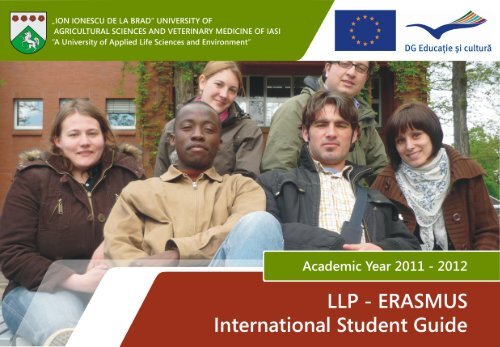
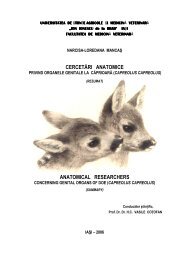
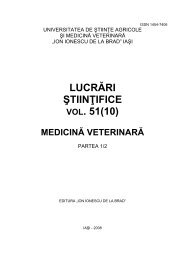
![rezumat teză [RO]](https://img.yumpu.com/19764796/1/190x245/rezumat-teza-ro.jpg?quality=85)
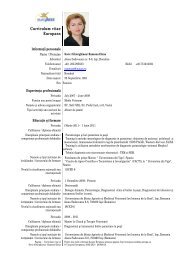



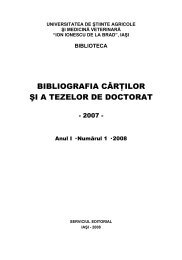
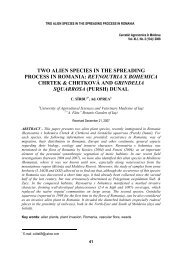
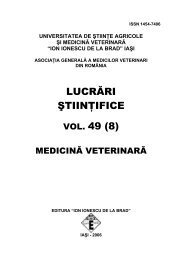
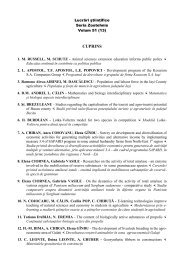
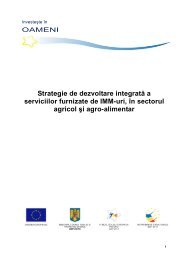
![rezumat teză [RO] - Ion Ionescu de la Brad](https://img.yumpu.com/14613555/1/184x260/rezumat-teza-ro-ion-ionescu-de-la-brad.jpg?quality=85)
